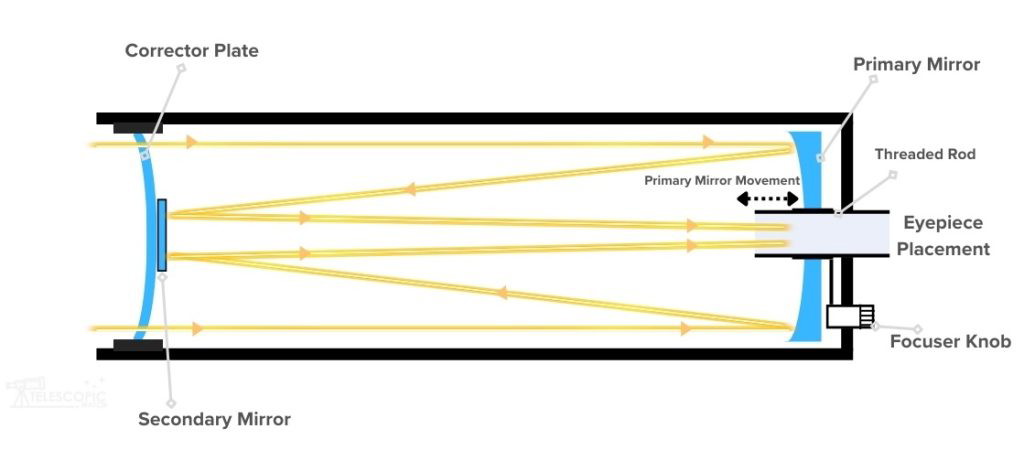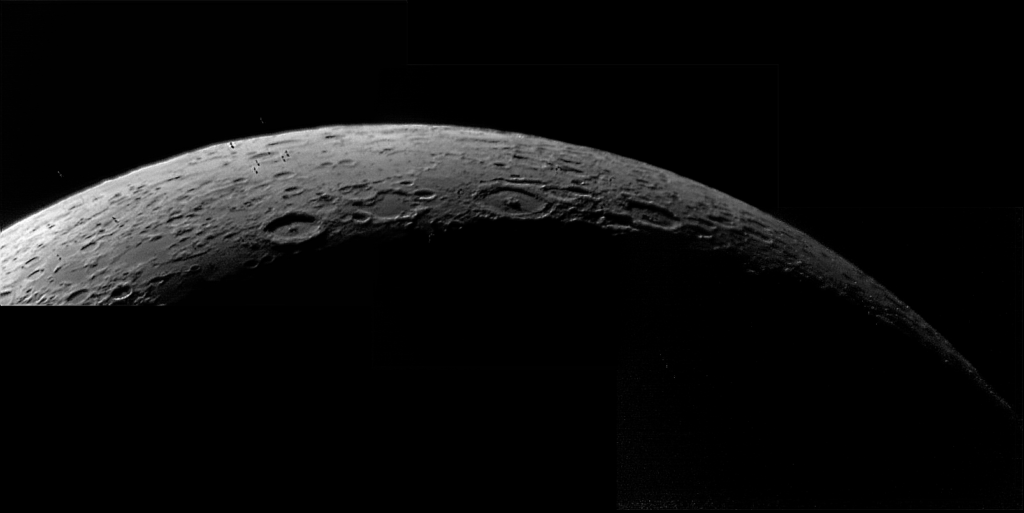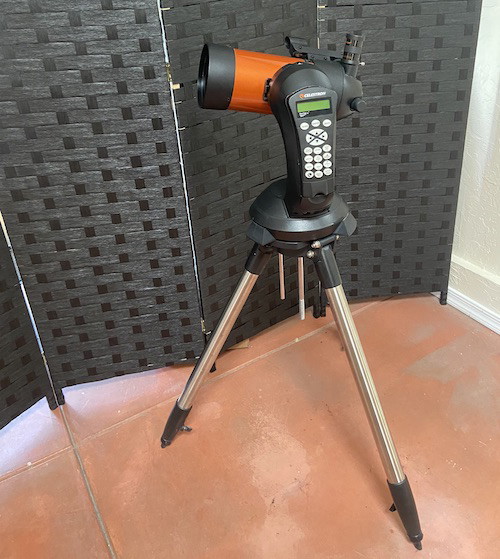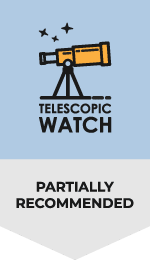The Celestron 4SE Optical Tube
The Celestron NexStar 4SE computerized telescope is a Maksutov-Cassegrain telescope with an aperture of 4” (102mm) and a focal length of 1325mm, giving it a focal ratio of f/13.
The Maksutov-Cassegrain design uses a very fast spherical primary mirror with a meniscus corrector lens and an aluminized “spot” on the corrector serving as the secondary mirror. The Celestron NexStar 4SE, like most mass-manufactured Maksutovs today, is a variant called the Gregory-Maksutov, where the secondary is nothing more than an aluminized spot on the back of the corrector lens.

The Benefits of 4SE’s Maksutov Design
Maksutov-Cassegrains, also referred to simply as Maks or Maksutovs, have small secondary mirrors and long focal ratios (typically f/12 to f/15), and the corrector lens and mirrors are very easy to make to high tolerances, making them provide stunning, sharp lunar and planetary views.
Since the secondary mirror in a Gregory-Mak is simply an aluminized portion of the corrector plate, commercial Maksutovs almost never need collimation. Some don’t have any provisions for doing it at all, but the NexStar 4SE has a few small collimation screws in the back that an experienced user could adjust for collimation.
The Pointless Flip Mirror
The 4SE has an integrated “flip mirror” at the back, which means that there is a built-in star diagonal that can be retracted to allow light directly out of the back of the telescope and into a camera adapter, usually for a DSLR or mirrorless camera. But this isn’t really necessary.
This flip mirror simply adds some additional bulk and complexity to the telescope and requires an unusual threaded adapter to be utilized. A normal Maksutov gets by with the user just detaching the star diagonal. The 4SE isn’t really intended for astrophotography anyway, especially not with a DSLR or mirrorless camera, which are primarily meant for long exposures.
NexStar 4SE’s Small Field Of View and It’s Effects
The Celestron NexStar 4SE, with its long focal length of 1325mm and use of 1.25” eyepieces, is limited to a maximum field of view of around just 1.2 degrees—or about 2.5 times the diameter of the full Moon. That’s a rather small figure for a 4” telescope.
An even larger aperture (130mm) but cheaper instrument, such as the Sky-Watcher Virtuoso GTi 130P, can get 2.5 degrees of field of view—more than double that of the Celestron NexStar 4SE (and they cost a fraction as much, to boot).
Of course, I realize that most of the advantages of that extra field of view are simply in finding objects manually, which the Nexstar 4SE does not need to worry about due to its fully computerized mount. However, a wide field of view is still desirable for many of the large star clusters, asterisms, and nebulae that a small telescope excels at.
Make no mistake: the Celestron NexStar 4SE is really a planetary telescope. Most deep-sky objects either don’t fit in 4SE’s field of view or don’t look particularly impressive.
If all you’re looking at is the planets, the Moon, and perhaps a few double stars, how much do you really need GoTo anyway?
Offering Just a Single Eyepiece & a Red Dot Finder
The Celestron NexStar 4SE computerized telescope comes with a single 25mm Plossl eyepiece, yielding 55x. This is good as a low-power or “finder” eyepiece for viewing deep-sky objects and initially aligning the telescope. But if you still want the best, for the widest possible field of view and lowest magnification with the 4SE, a 32mm Plossl is my favorite choice.
For optimal usage of the telescope, you’ll want something for higher magnifications. Specifically, a good high-magnification eyepiece in the 6mm to 9mm range, such as “goldlines”, the Meade 8.8mm UWA, or another eyepiece such as a Baader Hyperion or Explore Scientific 82-degree.
The only other accessory included with the 4SE is its StarPointer red-dot finder, which is used for aligning the telescope’s GoTo system.
The NexStar 4SE Mount
The NexStar SE mount is similar in all versions, but the 4SE and 5SE have a shorter fork arm on the mount and a base with 3 foot-like bits sticking out. It’s a holdover from the days of the NexStar 4GT, the 4SE’s predecessor, which was sold as a tabletop telescope.
The mount is well-made.
The gears in it are a bit better than the cheaper NexStar SLT scopes. But they still give me a lot of backlash, which is somewhat problematic when I’m moving the telescope at high powers or attempting to shoot planetary images.
The tripod legs are, however, solid steel. The whole assembly is actually somewhat overkill for the Celestron NexStar 4SE’s tiny optical tube.
One thing I’d like you to keep in mind with the SE mount is that the power jack can lose connection, which will shut down the mount. The mount then requires re-booting and re-aligning. I solved this issue by installing AA batteries in the scope as a backup.
The 4SE’s tripod has an “equatorial wedge,” which theoretically allows the scope to be converted to an equatorial configuration. However, without accurate altitude adjustments or any azimuth adjustment to speak of, short of picking up or kicking the entire scope/mount/tripod combination, an equatorial mount is only needed for deep-sky astrophotography. Deep-sky astrophotography is something that the 4SE, with a focal ratio of f/13, is simply not capable of (the mount’s mediocre gearing quality doesn’t help, either).
Why The Mount Doesn’t Make Much Sense To Me
The biggest issue I have with the 4SE’s mount is that it doesn’t make much sense.
The mount weighs 17 pounds, much more than it needs to weigh. It must be perfectly leveled during setup, especially if you want the SkyAlign easy-align feature to work. It either burns through lots of AA batteries frequently or needs a good, steady source of DC or AC power. And, of course, it has to actually be aligned.
All this is done in order to use a scope that, in all likelihood, can rarely be pointed at objects that can’t be found with the naked eye, a simple star chart, or even a phone app like SkySafari. Also, all of this is at the price of an 8” Dobsonian, which has four times the light-gathering ability, double the resolution, and a similar setup time at worst.
What can you see with the Celestron NexStar 4SE?
The Celestron NexStar 4SE shines primarily on the moon and planets.
- We can easily see lunar details just a few miles across, as well as the phases of Venus and Mercury.
- Mars will show its ice cap and some dark markings when it is close to Earth.
- Jupiter’s cloud belts, polar and equatorial zones, and Great Red Spot are visible, and its four largest moons, the Galilean Moons Io, Europa, Ganymede, and Callisto, appear as tiny, not-quite-stellar dots. With good atmospheric seeing, we can just see their shadows as they transit across the planet.
- Saturn’s rings, the Cassini division within them, and some faint, low-contrast cloud bands on the planet itself are no problem, and we are easily able to catch its largest moon, Titan, along with smaller moons such as Enceladus, Hea, Tethys, Dione, and Iapetus.
- Uranus and Neptune are nothing more than turquoise and deep blue dots; we would struggle to resolve the latter as more than a star at all.
Outside the solar system, the 4SE is relatively limited.
- Most galaxies, such as Andromeda, M81, and M51, appear as vague smudges of varying sizes under all but the best conditions (Andromeda and M33 will also be unable to fit into a single field of view with the 4SE). M82 is the only one that might show any detail, especially under light-polluted skies, in the form of a cigar shape and dark streaks perpendicular to it.
- Globular clusters are merely brightish fuzzy balls with maybe the slightest hint of resolution.
- A fair amount of open clusters are visible with the 4SE, but many are visually unappealing to beginners or don’t fit in the field of view.
- There are also a couple dozen nebulae visible with the scope, but overall, if you’re looking for mind-blowing views of deep-sky objects, you should probably look elsewhere. Visible does not mean spectacular.
Astrophotography with the NexStar 4SE
The Celestron NexStar 4SE GoTo telescope does well at lunar and planetary astrophotography.
I’ve attached a few images that I took with my NexStar 4SE and a cheap 640×480 webcam that I found at a flea market and attached a 1.25” nosepiece and 2x Barlow lens to.


Forget deep-sky astrophotography, however. The 4SE’s f/13 focal ratio, mediocre tracking capabilities, and the alt-az nature of the mount do not allow for good long exposure photos.
Alternative Recommendations
The Celestron NexStar 4SE is a decent enough telescope, but given its lack of performance or anything resembling good value for the money, we have quite a few alternative recommendations, regardless of whether you want a smaller and more portable computerized instrument or a larger but more capable Dobsonian telescope.
Under $700
- The Apertura AD8/Zhumell Z8/Orion SkyLine 8 offers double the resolving power, quadruple the light gathering area, and a significantly easier-to-use and more stable mount than that of the NexStar 4SE. You also get a pile of decent accessories included and features like a built-in cooling fan and 2” dual-speed Crayford focuser.
- The Sky-Watcher Virtuoso GTi 150P features GoTo just like the NexStar 4SE, but its 6” of aperture provides 50% more resolving power and about double the image brightness of the 4SE. As with the 4SE, you get a very compact instrument with GoTo, but with more performance and a lower price tag, controlled via your smartphone or tablet instead of a keypad. The 150P’s f/5 focal ratio and mere 750mm focal length produce a much wider field of view, too, and the telescope can be aimed manually with or without being powered on. The Heritage 150P, also offered by Sky-Watcher, is essentially identical to the Virtuoso GTi 150P, apart from its lack of electronics, making it a purely manual scope (but a great budget pick). The Sky-Watcher Virtuoso GTi 130P is similar to the GTi 150P but with less aperture.
- The Celestron Astro-Fi 130 boasts the same 130mm f/5 optics as the GTi 130P and is similarly operated with a smartphone, but is mounted atop a full-sized tripod, lacks a collapsible tube, and cannot be aimed manually. However, if you want a fairly compact and wide-field instrument that’s mounted atop a tripod, few better options exist in this price bracket than the Astro-Fi 130.
- The Celestron Astro-Fi 102 has the same optics as the NexStar 4SE, but without the latter’s goofy flip mirror and with a lighter and more advanced mount that can be controlled by your smartphone. A 10mm Kellner eyepiece is included along the stock 25mm, unlike the 4SE. If you like the NexStar 4SE, the Astro-Fi 102 has all the same positives but with a load of improvements.
$700-$1000
- The Apertura AD10/Zhumell Z10/Orion SkyLine 10 has 2.5x the resolution of the NexStar 4SE and more than 6.5x the light gathering area thanks to its humongous 10” primary mirror. The included accessories and features, as with the AD10/Z10, are simply excellent, the simple Dobsonian mount is a joy to use, and you get a ton of performance for the price.
- The Celestron StarSense Explorer 8” Dobsonian is similarly poorly accessorized to the NexStar 4SE—just one 25mm Plossl eyepiece and a red dot finder are included—but this scope offers some computerized capability in the form of the StarSense Explorer technology, which turns your phone into a precision pointing device, allowing you to find thousands of faint fuzzy deep-sky objects in seconds by pushing the scope around the sky. The Dobsonian base is also lightweight and the tube features carry handles to increase portability, too.
- The Sky-Watcher 8” FlexTube Dobsonian is a little more compact and thus easier to store and transport than a standard commercial 8” f/6 Dobsonian telescope thanks to its collapsible strut tube, and it includes an ample accessory kit (two 1.25” eyepieces and a straight-through 9×50 finder scope). However, the collapsible tube requires more assembly time and often more frequent collimation in the field, and it isn’t significantly lighter than a solid-tubed instrument.
Aftermarket Accessory Recommendations
A useful item is a real rechargeable battery to run the scope off of—the 4SE uses an enormous number of AA batteries and will gobble through a set after less than 24 hours of runtime. This makes a rechargeable supply a great investment that will quickly pay for itself.
I recommend the TalentCell 600Mah battery and a male-to-male power adapter. You can use Velcro, zip ties, or duct tape to secure the battery to the tripod leg.




I have se6 and I like it
I am looking at the 4SE because as you stated I’m a newbie and was intrigued by the features. So I’m looking for a better than average scope for viewing planets and if possible DSO’s. I’d prefer a simple set up and thats why I thought the GoTo appeared helpful, but if you’re saying its gimmicky, I can do without. What I would like is a scope for around $500 that has great optics, that will give me excellent detail of planets and would like to be able to see some DSO’s. I’d also prefer not to have to deal with collimation. Your recommendations please.
Thanks
6″ or 8″ Dob, maybe a 10″ if you can stretch your budget. Even a 6″ will blow the 4SE away on all objects.
Even though I respect the review, I have a 4se and it is pretty good for a newbie astronomer.
I have made some good astrophotography not only planetary ones. My picture of Jupiter is far way better than that the autor posted on this review. Also, by using the mosaic technique I took lots of pictures of orion’s nebulae.
Is it necessary an extra effort to achieve satisfactory results? Yes. But it is not impossible at all.
Also I use its wedge mounting with no problem. It really works.
Sky Alugn feature? Works like a charm. Rarelly fails.
I live in south hemisphere and before I first used it I read at celestron’s web site that there was a bug on its firmware wich consisted in alignment failure if it is performed in south hemisphere. So, they offered an upgrade of that firmware.
I downloaded it, followed the instructions and all get done without issues.
I use this telescope since 2009. It does its job.
Yeah, my astrophotos with the scope suck. Just thought I’d add them.
It’s really hard to do deep-sky astrophotography the way Celestron advertises, and the wedge is not exactly…. precise.
Hi Zane, being as I have over 1000 hours of observing under the belt on my 4se, I can say, for sure, the wedge does work, sky align works after the latest patch for the firmware (didn’t work for me before it 9/10 times).
Given that you don’t tap the scope, and don’t care about the wait time, you can get some pretty amazing shots of galaxies and nebulae if you know what to do. the scope itself is pretty good for planetary, and some D.S.O’s, but in reality, the mount is more along the lines of a star tracker for DSLR’s when in EQ mode.
The mount with wide field scopes works a charm, as if you opened a door into another dimension.
I think its safe to say, ditch the mak, get a camera and a 70-300/500 mm lense, and the proper dovetail to match it.
Hope this clears some stuff up about the EQ
Hi there I am really just getting into astronomy. I did have a telescope about 15 years ago but like most people it was only a cheap one and I was left disappointed. After coming across this site it has kind of rekindled my interest and am looking to buy a new scope and wanted really to see the planets as best as I can but also as much as I can of deeper space. I read your comments about DOB scopes compared to the celestron 4se I do realise that the two are really for different types of scope and prices but I have been looking at either Celestron 11049 NexStar 4 SE or the SKY-WATCHER SKYLINER 250PX 254MM (10″) F/1200 PARABOLIC DOBSONIAN TELESCOPE… I am leaning more toward the DOB but would really appreciate your view on the matter
I would get the Dob, the 4SE is pretty mediocre.
celestron nexstar 4se How much would one go for in today’s market
Used? Typically 300 bucks or so.
May I ask your advice about changing location a little bit more in details? You described the following feature of the telescope. I am going to buy 4SE in the USA and bring it back to Japan. Do I have to buy additional/other GPS module?
“Also, changing location is quite complicated. The scope really needs to come bundled with Celestron’s SkySync GPS module for updating time/date and location, which costs over a hundred dollars.”
Changing the location takes a while unless you happen to be located in one of the cities in its database (which still takes a bit). Not a huge deal, and you don’t strictly need the GPS.
However, if you like to haul the scope to a dark site several hours from home and observe frequently from both locations, you really need the GPS module.
I got the 4SE Nexstar as an outreach telescope. I am experienced observer who has owned a number of scopes over the past 30 years. The general public is most impressed with views of the Moon and planets, and this OTA delivers really sharp views of those. Even brighter open clusters look great.
I only use the manual 2-star alignment process, or even the Solar System align in the alignment menu, and tracking is great. GoTo slews are only as accurate as my centering of the alignment stars using a 10mm eyepiece. I would not recommend this to a novice. In my opinion, new folks should learn on classic, non-motorized 6 to 8 inch Dobsonians.
My wife bought this scope for me as a gift, although I had never used a telescope before. It’s sitting in a corner of my house unused. I cannot as a novice figure it out. Beginners obviously need to start with something simpler.
Agreed
Found a second hand 4SE for 200$…If it works OK I’m going for it.. Appart from testing motor/gear anything else? The construction of the OTA is quite sturdy as I understand?
Hello, is it worth buying this telescope for 160 dollars? (In open box condition)
At that price, sure.
Hi I’m very confused. i have read on Celstrons website that you can see the bands on Jupiter, That Mars appears reddish and you can see the ice caps. as well as other things. Ive seen pics on this site of Jupiter. The phone app that Celstron provides when it talks about the planets that you can see details.
I do see detail on the moon. Aside from that.
Here is the confusion. Whatever I view in the telescope without exception(again not counting the moon) Simply shows up as white. No detail, simple white objects in the telescope. Saturn shows up as a white ball with rings.
Am I missing something? Where is all the color and detail that everyone is talking about? I don’t even see lighter or darker variations of white. Simply white like a snowball.
I called Celstron and after waiting 4 days for them to return my call the tech first said it was a focus issue even after i told him that in the summer i could clearly see the rings of saturn(white) but i could clearly see them. and if it was a focus issue id still see out of focus color.
Then it was that it had to be colliminated after i checked the scope he told me that it is collimated internally. Don’t they know their own products?
Why do I only see white?
Any help would be appreciated since honesty Celstron really didn’t answer why everything was white.
Even on this site your saying that you can see the great red spot, bands, and Details on Mars.
How? Where?
Thank you
Adjust the focus knob and get a high magnification eyepiece
Hello everyone, I’m wondering is it possible to use other ota’s on the nexstar SE line goto mounts? Any examples? Thanks, clear skies
Yes but it will likely have clearance issues.
I have the se4 but the controller screen is red. I can’t see what is on the screen when I am outside . is there a way to change the colour
It is always red to preserve your night vision. Just turn up the brightness.
I did adjust the brightness but when it screen scrolls to fast and I can’t read most of the info.red is a bad color for a screen especially when it is dark outside. Also I can’t download the cfm since I have a Mac and iPads which most people use now. I have sky view downloaded on my iPads and it helps locate stars for me
is this a deal? brand new in the box Nexstar 4se $300., can a newbie find happiness?
This vs 130SLT and 102GT what’s better for sharper images of planets?
The 4SE and 130SLT are comparable for planetary viewing but there are better and larger telescopes available at this price point such as Dobsonians
Can anyone recommend a cheap finder scope for the 4se? the more i use the red dot finder, the more i hate it. I’m considering a cheap ebay celestron travel scope for around $50 that usually come with some accessories (not sure what i would need to mount it) OR as a premium choice I’m considering a stellarvue finder scope that comes with diagonal and a crosshair eyepiece in 60mm or 80mm. Thoughts?
https://www.ebay.com/itm/185542460582?ssPageName=STRK%3AMEBIDX%3AIT&fromMakeTrack=true
https://www.stellarvue.com/1-stellarvue-10×60-finder-scope/
I would highly recommend the Rigel Quikfinder